A Guide to Influencing Behavioral Health Budgets
Advocating for behavioral health services during budget discussions requires a multifaceted approach that incorporates understanding funding mechanisms, mobilizing community support, and navigating policy landscapes. This comprehensive guide explores effective strategies, key resources, and recent policy developments that empower advocates to influence mental health funding across government and organizational budgets.
Understanding the Global and Domestic Landscape of Mental Health Funding

What resources are available for those interested in advocating for mental health policy and funding?
For individuals and groups aiming to influence mental health policies, numerous resources are readily accessible. Organizations like the National Alliance on Mental Illness (NAMI) offer extensive advocacy tools, policy reports, and grassroots support programs aimed at shaping legislation and raising awareness.
The Substance Abuse and Mental Health Services Administration (SAMHSA) provides vital information on funding opportunities through grants, along with application support and guidance for research and workforce training initiatives that bolster behavioral health services.
The National Council for Mental Wellbeing advocates for increased federal and state investments in mental health care. They promote innovative service models and workforce development, offering resources such as policy briefs, action guides, and platforms for community engagement.
Mental Health America (MHA) plays a crucial role in legislative advocacy, focusing on expanding access, prevention, and health equity. They maintain strong communication channels with government agencies, supporting policy changes aligned with mental health priorities.
Legal and policy advocacy are further supported by groups like the Bazelon Center for Mental Health Law and Disability Rights organizations, which provide legal resources, policy analysis, and strategic counsel.
These organizations serve as essential tools for advocates seeking to influence funding, shape legislation, or advance community-based mental health initiatives.
How does the current investment landscape look globally versus in specific regions?
Globally, mental health continues to be a neglected area with remarkably low investment levels. The 2013 global average of health spending on mental health was only about 0.5% of total health expenditure, highlighting a significant gap in funding. High-income countries, such as those in Europe, have allocated roughly 5% of their health budgets to mental health, whereas low-income regions like Africa spend around US$0.10 per capita, starkly illustrating disparities.
Locally, the situation shows even greater variation. In 2017, the average domestic expenditure per person on mental health was just US$2.50 worldwide. European countries, for example, spend approximately US$21 per capita, whereas some regions in Africa remain perilously underfunded.
Less than half of WHO member states report on their mental health budgets, which hampers global efforts to monitor and address funding gaps properly. International aid for mental health is exceedingly limited, accounting for less than 0.5% of total development assistance for health in 2018.
Despite these gaps, a rising movement advocates for increased investment. The integration of mental health into the Sustainable Development Goals (SDGs) reflects a growing recognition of its importance. Countries and international organizations are pushing for policies that bolster funding, promote community-based support, and align with human rights principles.
Why is integrating human rights principles vital in mental health funding?
Embedding human rights into mental health funding models ensures that services respect individual dignity, promote community participation, and uphold non-coercive, rights-affirming care. This approach emphasizes that mental health services should be accessible, culturally sensitive, and designed with the community’s input.
Emerging models prioritize peer support, social justice, and holistic well-being, recognizing social, economic, cultural, and political determinants as crucial to mental health. These strategies oppose traditional, biomedical-only approaches that often exclude patient voice or rely on restrictive practices.
Financing mechanisms that align with human rights principles foster sustainable, inclusive mental health systems. They support vulnerable populations, including marginalized groups, and help eliminate stigma and discrimination.
What are the recent movements advocating for increased mental health funding?
Recent years have seen significant efforts at both national and international levels to combat underfunding. Legislation like the U.S. Congress’s passing of H.R.1 in July 2025 signifies policy shifts toward increased mental health investment.
Worldwide, advocacy groups push for a reallocation of resources toward community-based services, peer-led programs, and early intervention initiatives. Movements also endorse policies that integrate mental health into primary healthcare to widen access.
Prominent advocates promote innovative financing, such as implementing 988 crisis line fees, redirecting unspent funds, and fostering cross-sector collaborations. These efforts aim not only to increase funding but to ensure it is rights-based, equitable, and sustainable.
How do disparities affect mental health services and what can be done?
Disparities in mental health funding lead to unequal access to quality care, especially in underserved and marginalized communities. For instance, regions like Africa or rural areas often have less than US$0.20 per capita for mental health, resulting in insufficient services and higher untreated mental illness.
In high-income regions, despite higher budgets, disparities still exist among minorities and marginalized groups, who face barriers such as stigma, insufficient culturally competent care, and funding gaps.
To address these issues, advocates call for transparent reporting of mental health budgets, increased international aid, and policies that prioritize community-based, rights-affirming care. Investing in workforce expansion, infrastructure, and integrated services helps mitigate these disparities.
Summarizing the importance of funding and advocacy
Comprehensive and equitable mental health funding is essential for building resilient, inclusive systems that respect human rights and meet community needs. Advocacy organizations play a pivotal role in mobilizing resources, shaping policy, and raising awareness.
By understanding the disparities and available resources—ranging from community support programs to legislative tools—stakeholders can drive meaningful change. Collaborative efforts between governments, civil society, and communities are necessary to close funding gaps and foster a global environment where mental health is prioritized equally with other health concerns.
The Impact of Policy and Legislation on Funding Opportunities
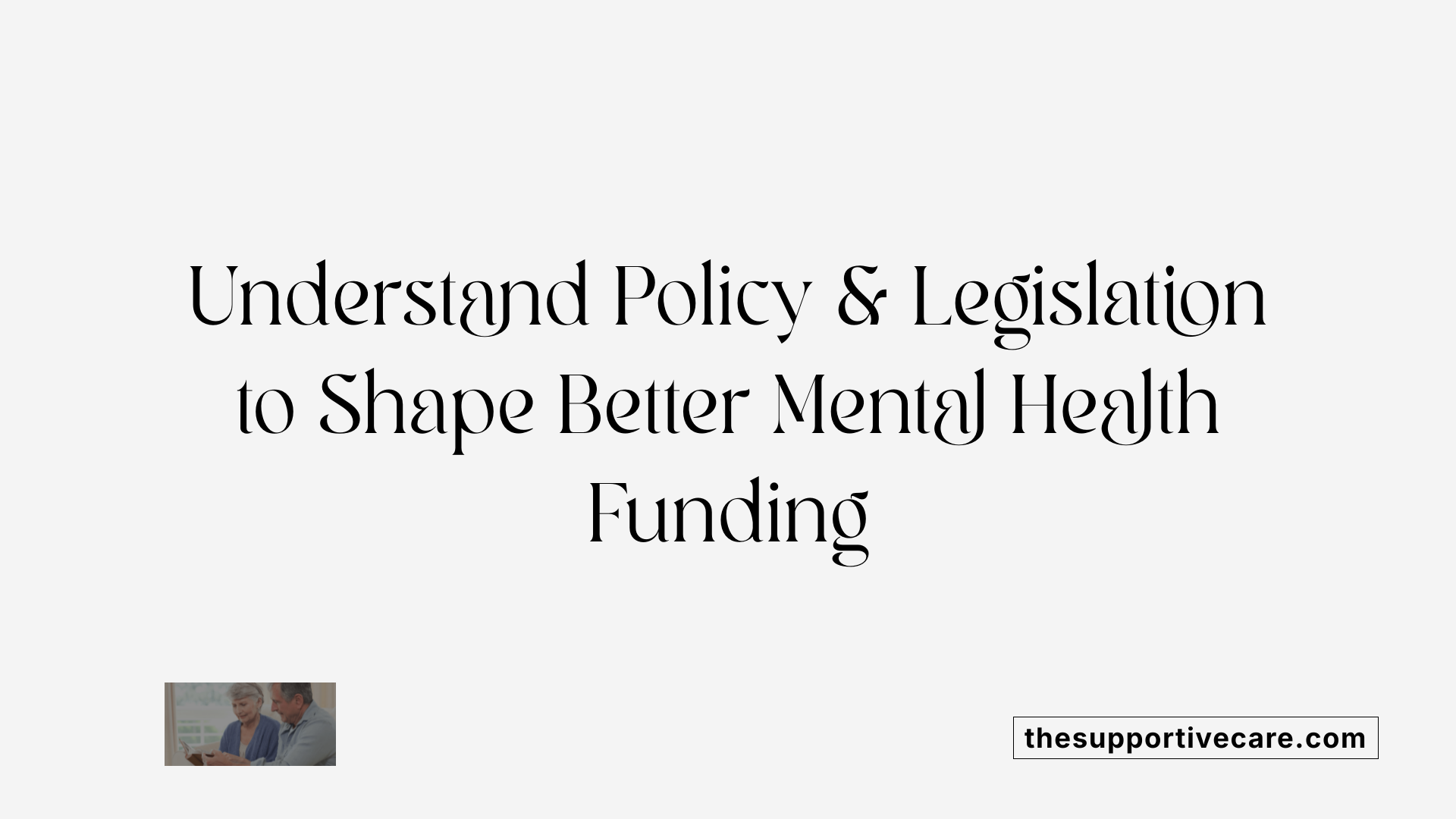
What are key points to emphasize when supporting behavioral health funding during budget discussions?
Supporting behavioral health funding requires highlighting its vital role in fostering community well-being, safety, and economic stability. Advocacy should underscore that investing in mental health reduces long-term costs by decreasing hospitalizations, emergency interventions, and involvement with the criminal justice system. Current funding threats, such as proposed cuts to Medicaid and programs like the Certified Community Behavioral Health Centers (CCBHC), jeopardize access for vulnerable populations and undermine service stability.
It's essential to call for continued and increased federal support, emphasizing that mental health services are foundational to public health and safety. Policy alignment should focus on integrating behavioral health into primary care and expanding crisis response mechanisms, like the 988 hotline, which are crucial for timely intervention.
Moreover, advocates should push for innovative workforce strategies, including training and hiring more mental health professionals, to address provider shortages—especially in underserved areas. Demonstrating that sustained and strategic funding can lead to better health outcomes, cost savings, and enhanced community resilience will strengthen appeals during budget discussions.
Recent legislative actions, such as the passage of H.R.1 and the effects on Medicaid and mental health funding
The legislative landscape significantly influences mental health funding. The passage of H.R.1, known as the 'One Big Beautiful Bill Act', on July 4th, 2025, marked a pivotal moment by reducing federal Medicaid funding by approximately 15%. This decrease is projected to result in around 11.8 million Americans losing access to Medicaid coverage, which is a primary funding source for mental health services.
Medicaid pays for critical services including therapy, medication, crisis intervention, and social supports. Cuts threaten to diminish or eliminate these services, impacting millions, especially in rural and underserved communities. Additionally, the federal government has announced it will not enforce recent mental health parity regulations, which mandated insurers provide equal coverage for mental and physical health conditions. This rollback can lead to increased out-of-pocket costs and reduced access.
Further, restructuring efforts within federal agencies, such as the proposed dissolution of SAMHSA and HRSA in the FY26 budget, threaten to weaken mental health infrastructure and workforce development. These agencies currently support training, research, and community-based services.
The role of federal and state legislation in shaping mental health budgets
State-level actions significantly influence local mental health services. For instance, California’s Proposition 1, passed in 2024, aimed to fund $6.38 billion through general obligation bonds to expand treatment and residential facilities, including supportive housing for vulnerable populations.
Similarly, Wisconsin’s proposed budget includes $300 million for school-based mental health programs, crisis stabilization centers, and expanding Medicaid coverage. These investments are designed to increase access, especially for children, youth, and rural residents.
Local initiatives like Montgomery County's community support programs and advocacy groups such as the California Behavioral Health Association work within this landscape to propose legislation, allocate funds, and advocate for policies that improve service delivery.
How restructuring of federal agencies impacts mental health funding
Reorganizing federal agencies can have profound impacts on funding streams and program priorities. The potential dissolution of SAMHSA (Substance Abuse and Mental Health Services Administration) and HRSA (Health Resources and Services Administration) is particularly concerning. These agencies administer grants, facilitate workforce training, and support community programs crucial for maintaining and expanding mental health services.
Dismantling or reducing their budgets could lead to gaps in services, reduced training opportunities, and diminished innovation in behavioral health care. Conversely, well-funded agencies can drive forward national strategies for mental health parity, crisis response, and integrated care.
The significance of local, state, and federal funding initiatives, including proposals like Prop. 1 in California
Funding initiatives at all levels are vital to addressing mental health needs. California’s Prop. 1 exemplifies a comprehensive approach, proposing to create a dedicated bond to expand treatment facilities and supportive housing, directly tackling homelessness and access issues.
State budgets, such as those in Wisconsin and Pennsylvania, often include provisions for school mental health, crisis centers, and expanding Medicaid. These efforts are complemented by local programs and advocacy campaigns that push for the allocation of resources aligned with community needs.
Overall, success in mental health funding depends on coordinated efforts across all levels of government, ensuring sustainable support that adapts to evolving service demands and demographic shifts.
Resources and Strategies for Effective Policy Advocacy
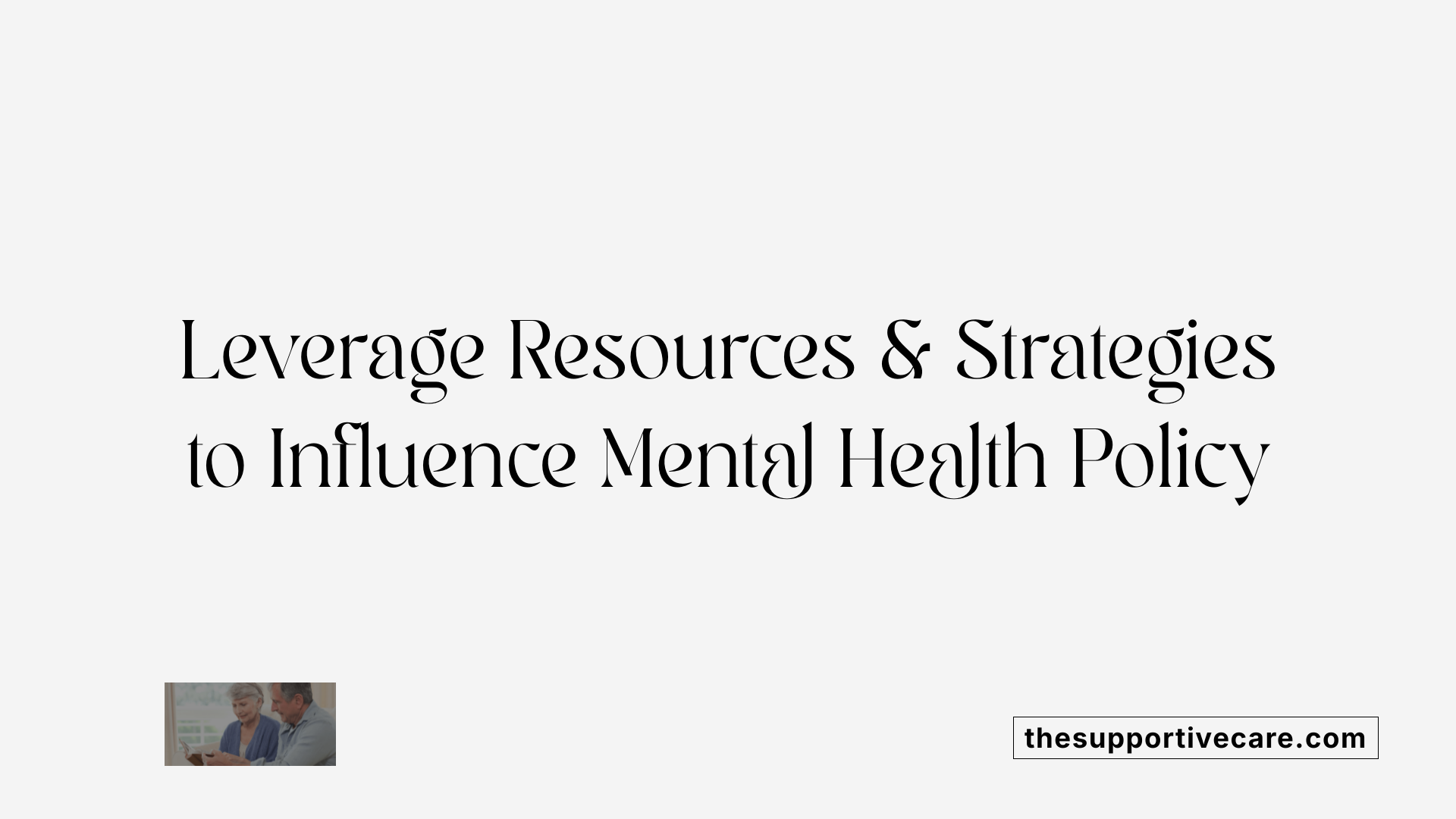
What are effective policy advocacy techniques for behavioral health services in budget decisions?
Advocacy for behavioral health funding relies on a combination of strategic engagement, compelling communication, and targeted campaigns. Building broad coalitions is essential; this involves engaging diverse stakeholders—patients, families, community organizations, healthcare providers, and policymakers—to create a unified voice. Such coalition-building amplifies influence and presents a collective front when petitioning for increased funding.
Employing data, personal stories, and community narratives can significantly influence public debate and decision-making. Concrete statistics demonstrate the urgent need—for example, highlighting that over 72 million Americans rely on Medicaid for mental health services or that a single study in Indiana found a societal cost of $4.2 billion due to untreated mental illness. Personal stories humanize these issues, creating emotional resonance that promotes empathy and understanding.
Advocates should leverage various tools such as letters to legislators, social media campaigns, and grassroots lobbying sessions. Writing personalized, well-researched advocacy letters can persuade lawmakers, while robust social media engagement raises awareness rapidly and mobilizes community action.
Understanding the policy landscape is critical. Recognizing windows of opportunity, such as upcoming budget hearings or legislative sessions, allows advocates to time their efforts effectively. Aligning advocacy strategies with broader health equity and social justice goals ensures that mental health initiatives promote racial, economic, and social fairness.
Funding approaches can be creative; blending, braiding, and sequencing multiple sources—such as federal grants, state budgets, and private partnerships—can increase financial sustainability. Advocates play a vital role in educating stakeholders about these innovative funding mechanisms.
Finally, ensuring compliance with legal and procedural rules, preparing evidence-based materials, and maintaining persistent, coordinated efforts are vital. This multi-pronged approach enhances the likelihood of influencing budget decisions, ultimately expanding resources for behavioral health services and advancing health equity.
Mobilizing Community and Stakeholder Support
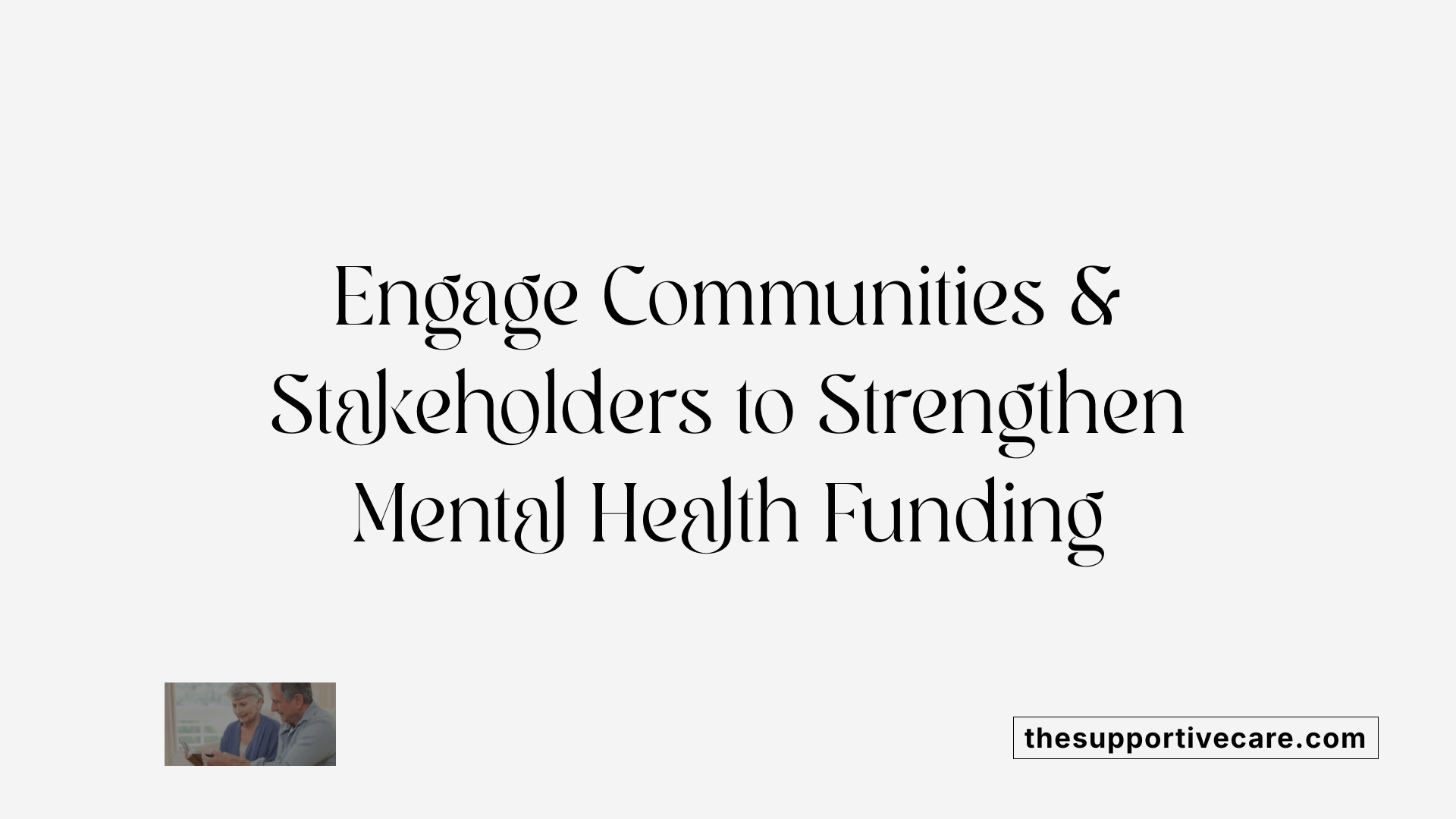
What are effective strategies to mobilize community or stakeholder support for behavioral health funding?
Engaging communities and stakeholders is crucial in advocating for increased and sustainable behavioral health funding. One of the most effective tactics is launching targeted outreach and education campaigns. These initiatives aim to inform community members, local organizations, and policymakers about the pressing mental health needs within the community and the broader social benefits of adequate funding.
Organizing community forums, town halls, and participatory research projects—such as Community-Based Participatory Research (CBPR)—can foster shared ownership. These platforms allow diverse voices to contribute to planning and decision-making, solidifying broad-based support.
Building strong partnerships is also vital. Collaborations with faith-based groups, local nonprofits, schools, and social support networks can multiply outreach efforts and embed mental health initiatives within trusted community institutions. Incorporating community health workers and peer support specialists helps bridge gaps and enhances cultural competence.
Capacity-building efforts, including training and technical assistance, empower community members to become advocates and active participants. Equipping local leaders with knowledge and resources enables them to promote mental health initiatives effectively.
Demonstrating tangible, positive outcomes further cements support. Showcasing success stories and data that highlight improvements in health, safety, and social cohesion can persuade policymakers and funders of the value of sustained investment.
Tailoring interventions to meet the specific cultural and social needs of vulnerable populations—such as racial minorities, LGBTQ+ individuals, and those in rural areas—is essential for inclusive support. When communities see their priorities reflected, advocacy gains momentum.
Overall, a comprehensive approach combining community outreach, partnership development, training, and outcome demonstration can significantly strengthen efforts to secure and sustain behavioral health funding.
Maximizing Advocacy Impact Through Education and Community Engagement
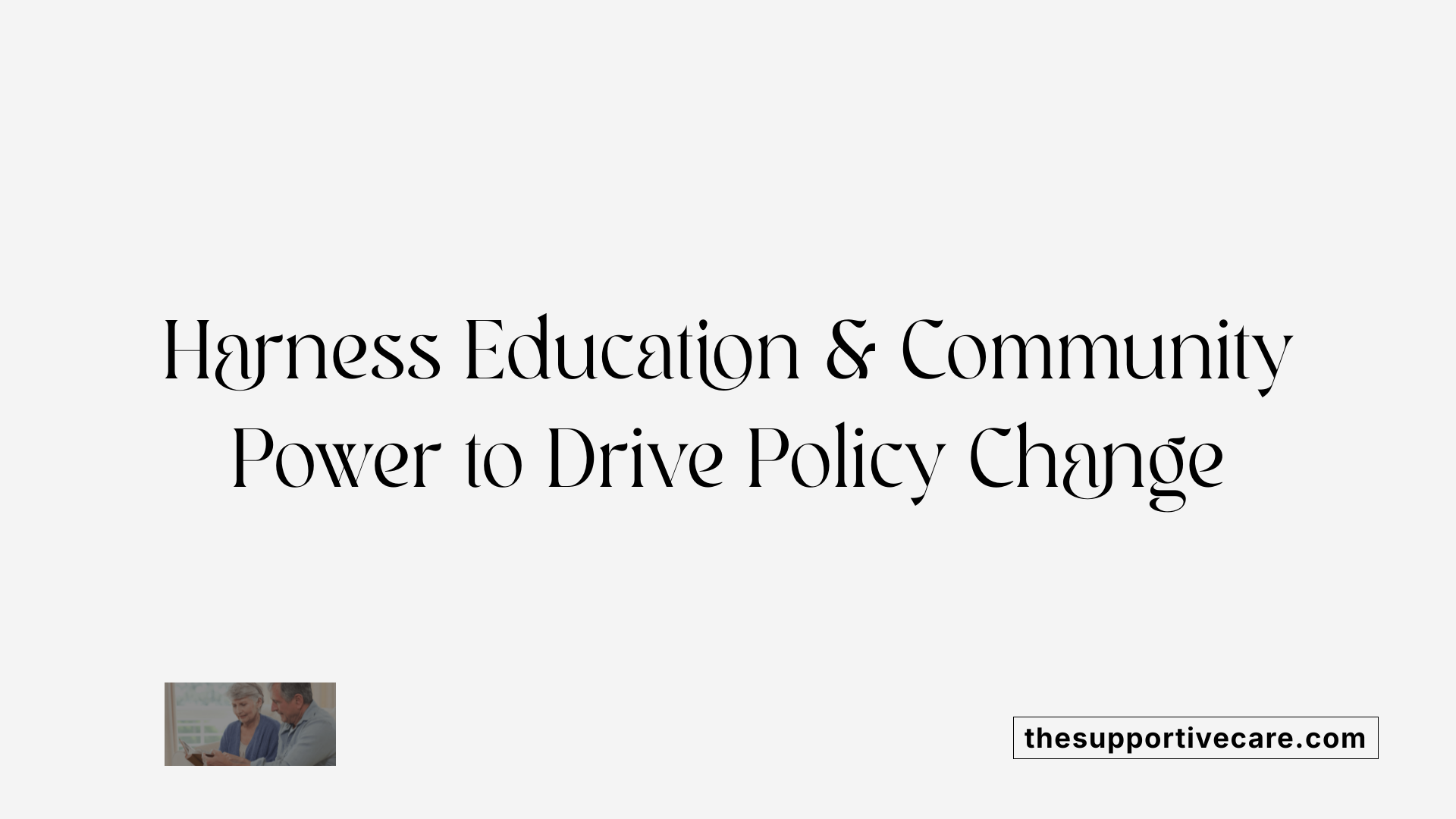
How can individuals get involved in advocacy efforts to support behavioral health funding?
Active participation is crucial in advancing mental health priorities. Individuals can become involved by volunteering with reputable organizations like the National Alliance on Mental Illness (NAMI), Mental Health America, or local mental health groups. These organizations often offer programs such as NAMIWalks, advocacy campaigns, and awareness events that facilitate community engagement.
Engagement doesn’t stop at volunteering; building partnerships with community leaders, faith communities, educational institutions, and local businesses can significantly amplify advocacy efforts. These collaborations help raise awareness, diminish stigma, and promote culturally sensitive mental health initiatives.
Staying informed about current policy issues is also essential. Advocates should educate themselves on mental health challenges, legislative changes, and funding priorities. Resources like advocacy handbooks, fact sheets, and template letters to legislators streamline the process of policy advocacy.
Sharing personal stories adds a powerful human element to campaigns, fostering empathy and understanding among policymakers and the public. Personal narratives are effective in reducing stigma and motivating community action.
Participation in community events such as town halls, policy camps, and educational forums provides opportunities to voice opinions directly, influence decision-makers, and learn about upcoming legislative efforts.
Supporting legislation through petitions, letter-writing campaigns, and social media advocacy broadens the reach of these initiatives. Digital platforms allow advocates to mobilize supporters quickly and effectively.
Finally, connecting with regional resources, attending advocacy trainings, and setting clear goals helps maintain a focused strategy. By combining education, story-sharing, event participation, and coalition-building, individuals can significantly enhance the impact of mental health advocacy efforts.
Funding and Policy Innovations to Strengthen Behavioral Health Systems
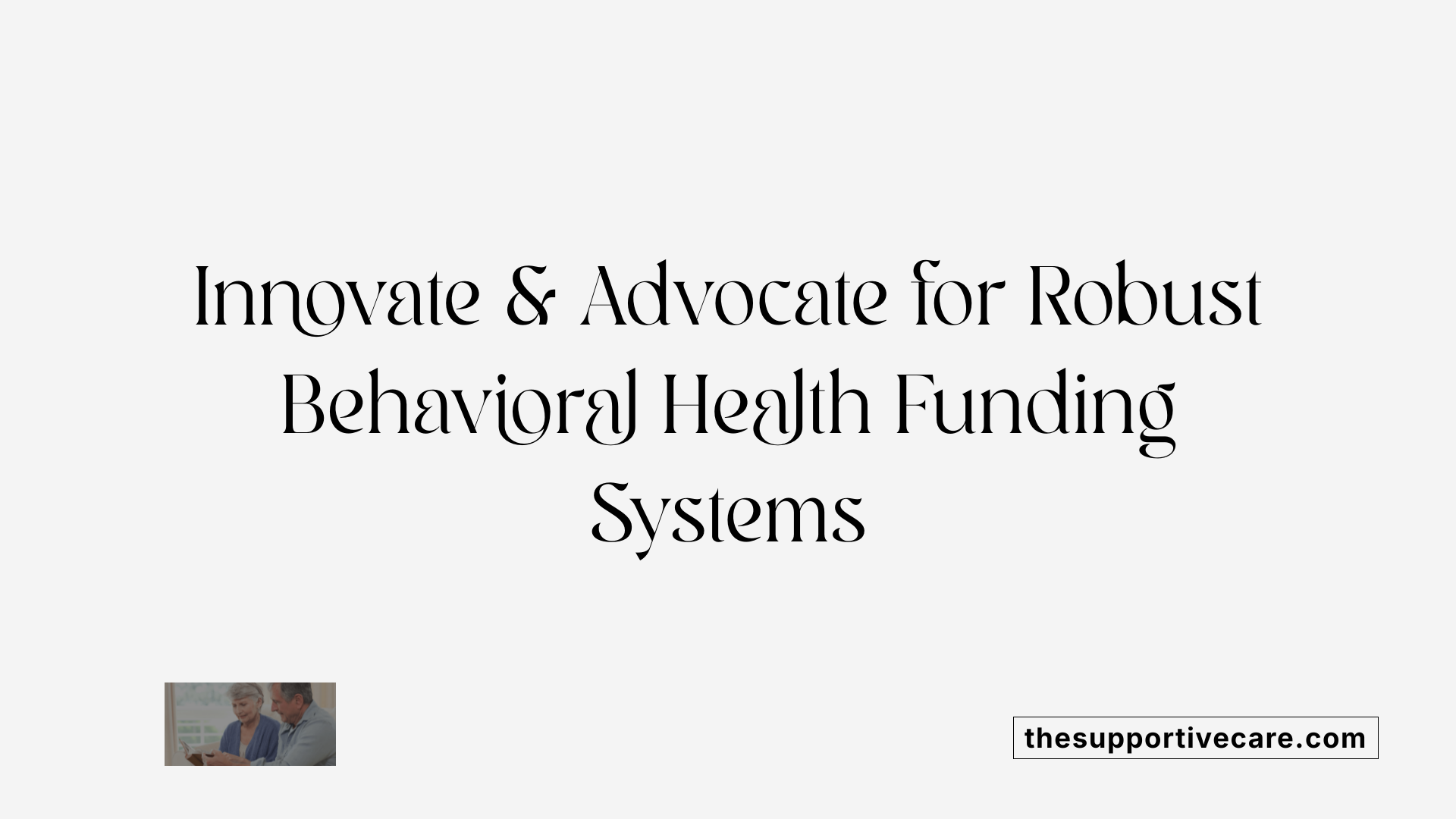
How can advocates influence mental health funding in budget negotiations?
Advocates play a crucial role in shaping mental health funding through persistent engagement with policymakers and stakeholders. They can influence budget negotiations by actively reaching out to legislators through calls, emails, and letters, emphasizing the importance of robust mental health services and urging increased investment.
Building a broad coalition of support is essential. Advocates should mobilize community allies such as healthcare providers, law enforcement agencies, local businesses, affected individuals, and families to demonstrate widespread backing for mental health priorities.
Using data-driven approaches helps strengthen their case. Presenting evidence on the societal costs of underfunded mental health systems—like increased incarceration, emergency room visits, and lost productivity—can persuade policymakers to prioritize funding.
Highlighting long-term benefits is key. Advocates should focus on rights-based approaches that promote community-based, non-coercive services aligned with social justice principles.
In addition to traditional lobbying, advocates can promote innovative financing options such as grants, public-private partnerships, and targeted contracts that provide flexible funding streams.
Leveraging technology—like advocacy platforms, social media campaigns, and digital petitions—can amplify messages and engage a wider audience.
Preparing for potential funding volatility, especially from federal sources like Medicaid, is also vital. Advocates should push for contingency plans and flexible spending strategies to ensure continuity of care amidst shifting budgets.
By combining persistent advocacy, coalition-building, rigorous data, and innovative proposals, advocates can significantly influence mental health funding in budget negotiations and promote sustainable, rights-affirming systems.
Recent and Proposed Federal and State Initiatives Affecting Behavioral Health Funding
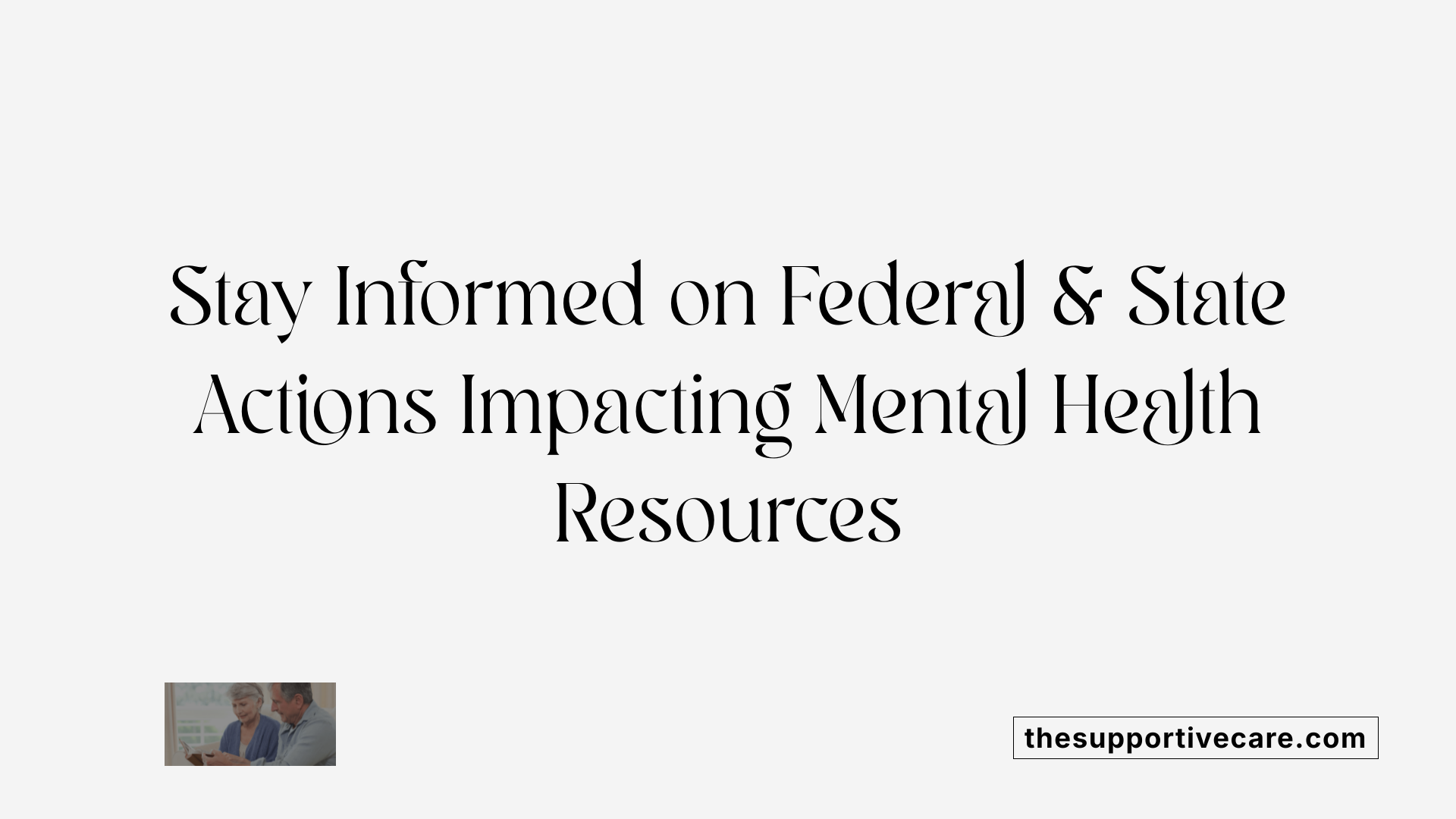
How does understanding funding mechanisms aid in advocating for behavioral health services?
Understanding funding mechanisms is essential for effective advocacy because it provides insight into how various programs are financed and maintained. This knowledge allows advocates to identify potential sources of support, such as federal grants, Medicaid, state budgets, and innovative reimbursement models tailored for mental health. Recognizing how these streams operate enables advocates to navigate complex legislative and budget processes, making it easier to push for policies that sustain or expand funding.
For example, knowing that Medicaid is a primary source for behavioral health services—covering therapy, medication, crisis support, and social services—empowers advocates to lobby against cuts that threaten coverage for millions. Similarly, awareness of recent legislative actions, like the passage of H.R.1 reducing federal Medicaid funding, helps advocates craft targeted campaigns to oppose reductions and protect access to care.
Advocates can leverage knowledge about emerging models such as Community Behavioral Health Clinics (CCBHCs), which expand access to comprehensive, community-based services, and understand how innovative payment structures can ensure sustainability. Understanding the intricacies of funding also highlights gaps, such as disparities in domestic and international aid, that need addressing through policy change.
By grasping how funds are allocated and the effects of policy shifts, advocates are better positioned to influence lawmakers, push for equitable distribution, and promote long-term investment in mental health care. Strategic advocacy rooted in a solid understanding of funding mechanisms increases the likelihood of securing stable, adequate resources needed to meet growing mental health demands.
Federal Medicaid cuts and their implications
Federal budget proposals and legislative actions pose significant threats to mental health funding. For instance, the House of Representatives recent budget resolution could lead to drastic cuts of over $715 billion to Medicaid, affecting over 72 million beneficiaries. It is estimated that such cuts could result in approximately 13.7 million more Americans losing Medicaid coverage, including many who rely on these services for mental health care.
Medicaid is the main funding source for a wide range of behavioral health services, including inpatient care, outpatient therapy, and crisis interventions. Cuts threaten to reduce eligibility, decrease benefits, or lower payments to providers, which could result in fewer providers accepting Medicaid patients and diminished access to essential mental health resources.
The potential loss of federal funding may also lead to increased reliance on law enforcement and emergency services, escalating societal costs and worsening condition management for vulnerable populations. Advocacy groups such as NAMI and others are actively opposing these cuts, urging policymakers to protect Medicaid to ensure continuous access to mental health services.
State-level proposals to increase funding, such as in Wisconsin, California, and Pennsylvania
States are exploring varied strategies to bolster mental health resources amid federal uncertainties. Wisconsin’s recent budget allocates approximately $300 million primarily for school-based mental health programs, crisis stabilization centers, and community services. These investments aim to expand access, improve early intervention, and reduce reliance on emergency services. California’s Proposition 1, approved by voters, authorizes for a $6.38 billion bond to develop treatment facilities, create supportive housing, and expand outpatient services. This measure aims to dramatically increase infrastructure and residential options, particularly benefiting homeless populations and veterans. Pennsylvania has proposed increasing funding through a $100 million mental health initiative targeting K-12 schools and community-based services. It also includes allocations for crisis hotlines, housing, and legal support to address social determinants of mental health. These state initiatives reflect a strategic move to offset federal funding gaps by investing in infrastructure, workforce, and community supports, emphasizing comprehensive and equitable care approaches.
The impact of new initiatives like Prop. 1 in California, and regional programs in various states
California’s Prop. 1 exemplifies transformative funding for behavioral health. It aims to expand treatment capacity, support housing, and reduce homelessness among those with behavioral health challenges. Other states are implementing regional programs to address specific needs—such as Wisconsin’s crisis centers, Texas’s expansion of telepsychiatry, and Pennsylvania’s focus on school mental health. These regional programs facilitate tailored solutions, improve access in underserved areas, and address shortages of providers. However, these initiatives also face challenges like managing debt obligations from bonds, coordinating multi-agency efforts, and ensuring sustainable funding. They illustrate the importance of leveraging state and local resources to supplement federal programs, providing resilient and community-centered mental health support.
Potential threats posed by federal restructuring and funding reductions
Federal restructuring proposals threaten to diminish the scope and quality of mental health services nationwide. The proposed dissolution of agencies like SAMHSA and HRSA could weaken infrastructure for workforce training and public health initiatives, while halting or reducing funding for crisis lines and prevention programs. Further, the recent deregulation efforts, such as not enforcing mental health parity regulations, decrease insurers' obligations to cover mental health equally, leading to increased out-of-pocket costs and reduced access. Downscaling programs like the Children’s Crisis Team or limiting inpatient stays through Medicaid cuts directly threaten timely intervention, especially for vulnerable groups such as children, minorities, and rural populations. Advocates warn that these reductions could exacerbate disparities, increase societal costs through higher emergency and inpatient utilization, and leave many without necessary care. Therefore, ongoing vigilance, proactive advocacy, and strategic policy engagement are necessary to counteract these threats and preserve mental health services for all.
| Topic | Key Points | Implications |
|---|---|---|
| Federal Medicaid cuts | Major reductions proposed, affecting millions | Increased uninsured rates, reduced access |
| State funding proposals | Wisconsin, California, Pennsylvania expanding | Infrastructure growth, community services |
| New initiatives | Prop. 1, regional programs | Improved access, targeted support |
| Federal restructuring | Potential agency dissolutions, regulations rollback | Weakened infrastructure, increased disparities |
| Advocacy and response | Mobilization efforts, legislative engagement | Essential to protect and expand services |
The Path Forward: Strategic Advocacy for Lasting Impact
Advocating effectively for behavioral health services within budget discussions necessitates a comprehensive understanding of funding landscapes, strategic stakeholder engagement, and policy insight. By leveraging available resources, mobilizing community support, and employing targeted advocacy techniques, stakeholders can influence budget priorities and secure vital resources. As global, federal, and state initiatives evolve, advocates must stay informed and adaptable, emphasizing the social and economic benefits of mental health investment. Through sustained effort and collaboration, it is possible to build resilient, equitable mental health systems that meet the diverse needs of communities now and in the future.
References
- Addressing the Problem of Severe Underinvestment in Mental ...
- Potential Effects of Mental Health Funding Cuts in 2026 | Eleos Blog
- Mental Health & Housing: Budget Highlights and Advocacy in PA
- Key Takeaways: DC Behavioral Health Budget Hearing for Families ...
- Advocates for improved mental health care predict 'consequences ...
- NAMI Statement on House Budget Resolution Putting Mental Health ...
- 2025 Behavioral Health - League of Women Voters of Washington
- Mental Health Advocacy and Its Importance in Public Health
- New Policies Affecting Access to Mental Health Care
- 8.6 Million People on Medicaid: Alarming Impact of House Budget ...



































































































